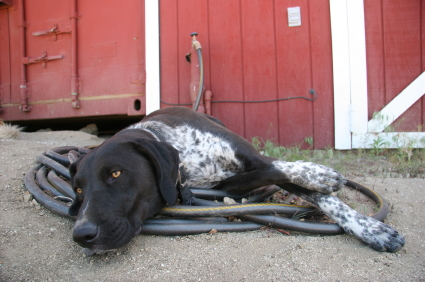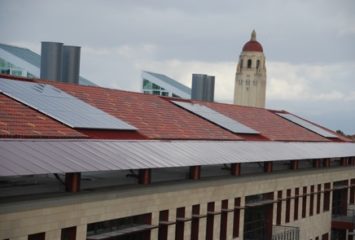DIY Solar Pool Heater
This morning one of our readers sent us a little do it yourself tip for heating a swimming pool based on what one of her friends is doing. The full comment follows: “Not a question, but a little info: Knowing how hot the water gets in a garden hose, a friend with a swimming pool bought a bunch, I do not know how much, of black garden hose. She spread it out in big curls on top of a nearby flat roofed building. She then fixed up a small recirculating pump, ran the water to the swimming pool to warm the water. Worked great!”
While this comment doesn’t come with too many details about how much hose was used, what kind of pump was used, or even where in the US this is being done… The fact that nearly anyone can harness solar energy to do something useful is very evident. This dog for example, found a great way to enjoy a black garden hose and harness a little solar energy to stay comfortable.
After receiving this comment we decided to figure out just how much something like this would cost to do so we sought out some pricing information online. First off we looked for a hot water recirculating pump and found out that there are several different types in the range of $200 to $300 all designed to connect to a hot water heater. Since water heaters connect using smaller pipes than a garden hose, you would probably need an adapter or two from the Home Depot or other similar store. Next up is black garden hose; we found a nice bundle measuring 100 feet long at $50 that would work pretty well but you might need even more length which would require an extender like this, you would also want to be sure that the system didn’t leak because your motor could burn out that way. You can buy little rolls of sealant tape at most hardware stores to be used when screwing in one end of hose to another.
Here are a few more tips to keep in mind if you do try to setup a makeshift pool heater using solar energy.
- Don’t leave the system on overnight, that will just waste electricity and potentially even cool your pool down.
- Realize that while solar heat energy is free the electricity needed to run a water circulator is not free – you might want to consider electric solar panels from Home Depot to power your solar water heater!
- If water leaks out of your system (from any of the hoses attached to the pump running through the pool) the circulator could get ruined or burn out.
- Do not use an extension chord to connect the hot water circulator, it needs to connect directly to a house outlet, always be careful when dealing with electricity and water (Solar Power Authority is not providing professional advice here, simply tips that a user has submitted to us) please consult an expert and be very careful with projects like this.
[UPDATE] We followed up with the person who sent us this tip requesting more details about how the system worked and where it was located and she had this to say: “Hmm… My location is Central Florida. I knew some people on the windy side of “The Big Island” Hawaii who did this too. Now I have no way of contacting either of these people, sorry. About the only thing I could do is contact pump sellers and ask. small recirculating pumps people use for decorative gardens would not have the power to get the water up to the top of a building. No doubt if the hose coils were level with the pool, it would be an energy ($) saving. I’m pretty sure the circulation was on daily after the sun was high enough to heat the water in the hose. Of course this varies according to time of year and latitude. . Does this work only in southern areas? Is it only good where the water needs 10-15 degrees of warming? I do not know the answers. Sorry I’m not more help”
Please share your success stories, better prices on garden hoses and circulators, and other comments below.



3 Comments
I Love your photo of the dog! Exploring your links, There are other pump options such as northerntool.com Others from northern tool, among other sellers. Anyone contemplating such a set up might do well to discuss the pump and the lift requirements with a local pump seller. Even moderate size towns have someone who sells pumps, especially in areas where there are wells for household or irrigation water.
The buyer would have to get the connection adapters, from a pipe seller, or the pump seller. These are not complicated. But the hose extensions you have pictured are not what they would need.
In the bullet 2, do you mean “to power your pump”? The pumps I’m familiar with have cut-offs to prevent burn out in case of lack of water or low pressure, or sometimes if there is a power outage and the pump looses it’s prime. Whew, lots to consider.
I live in Pensacola and use solar heated water. My home made system: 50 ft of black, half-inch sprinkler tubing laid out in loose coils on black poly sheet. A cheap submersible pump is connected to the tubing and sits in the bottom of the ‘water tank’….a 32 gallon trash can (bought new from Home Depot). The most expensive component is a marine/RV pressure pump connected to a 15 ft garden hose and sprayer, used in a camp shower tent in my back yard. My electric water heater is essentially turned off from May to October, reducing my electric bill significantly. The water is HOT on a sunny day, requiring mixing with cold water to be comfortable. For winter I’ll build a better collector and insulate the container to use warm water for laundry.
One comment about your solar powered pool heater. Using a small solar pannel to run the pump would negiate the cost of running the pump as well as ensure it only ran when there was solar power available to heat the water… :-)
Same idea as the solar powered ventilation fans for atics.